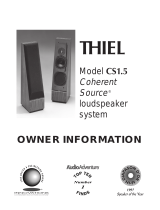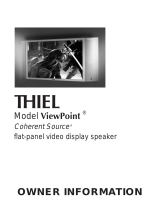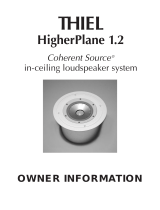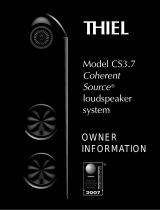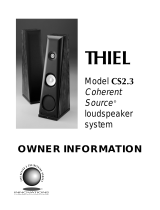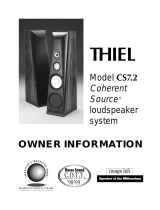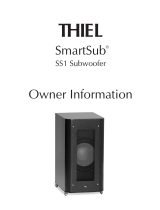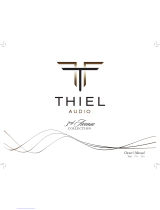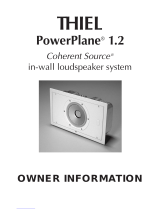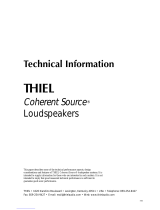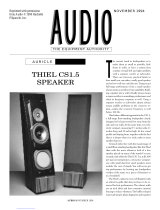Page is loading ...

OWNER INFORMATION
THIE L
PowerPoint
®
1. 2
Coherent Source
®
surface-mount loudspeaker system
2001-04
Editors’ Choice
Award
HOME AUTOMATION
MAGAZINE
“Editor’s Pick”
Top 50
Products

C
ongratulations on your purchase of the THIEL PowerPoint
®
1.2 surface-mount loudspeaker. This
product is the result of a dedicated effort to provide very accurate and realistic sound reproduction.
We have used very high quality components and taken great care in the PowerPoint 1.2’s construction.
Properly set up and used with good associated equipment, the PowerPoint 1.2 will provide you with a
great deal of sonic enjoyment for many years.
Jim Thiel, Product Designer, THIEL Audio
SPEAKER PLACEMENT
The PowerPoint 1.2 can be placed in a wide variety of locations throughout the room on ceilings and walls. The speaker’s
wedge shaped cabinet and coaxial driver mounting allow the PowerPoint 1.2 to optimize the coverage area for a variety of
speaker placements and listener positions.
To achieve the best sonic results, the cabinet
should be oriented so that the drivers are
facing toward the center of the room. For
example: When used as a front right and left,
rear right and left, or center channel speaker,
the PowerPoint 1.2 can be mounted on the
ceiling with all of the speakers radiating
toward the center of the room.
SURFACE MOUNTING INSTRUCTIONS
It is important that the PowerPoint 1.2 be mounted securely to prevent unwanted
vibration. The PowerPoint 1.2 is secured to its mounting surface with two screws,
one located along the rear edge of the cabinet, and one in the front located under the
THIEL logo. The logo is attached with removable adhesive and is removed by
pushing it from the speaker by inserting a small phillips screwdriver, or something
similar, through the cabinet’s mounting hole. A mounting template is included with
the speaker to assist in accurately positioning the mounting holes in the wall or other mounting surface.
Tape the template to the mounting surface in the desired position. Drill the two holes in the positions marked on the
template with a
1
⁄16" drill bit to a depth of 2 inches. Any holes in which a wall stud is encountered (where material is
continued to be drilled beyond a depth of approximately
1
⁄2") should be left as-is and the included #6 mounting screws should
be used for these holes. Any holes which are through only dry wall (where the drill “falls through” after the first
1
⁄2" of depth)
should be enlarged to
1
⁄4" with another drill bit and the included molly bolts should be used for these holes. To install the
molly bolts, insert the molly bolt into the wall and tighten the screw until the molly is secure with its flange tight against the
wall. Then remove the molly bolt screw.
Connect the speaker wires to the speaker, position the speaker in place and drive the two screws through the cabinet’s
holes and into the wall, using the appropriate type of screw for each hole (either a wood screw or a molly bolt). Replace the
logo by pressing it into the recess in the front of the speaker.
5-channel ceiling-mount installation

CONNECTING THE SPEAKERS
Speaker wire can be routed through a drilled opening in the mounting surface for a hidden connection. The PowerPoint 1.2
uses 5-way binding posts which accept several types of speaker cable termination. Make sure that all connections are tight.
It is essential for proper performance that both speakers in a stereo system be wired in the same polarity. The speaker’s input
terminals are color coded to facilitate this. The wire connected to the red ringed input terminal of each speaker should connect
to the respective positive (+) output terminals of the amplifier; the wire connected to the black ringed input terminals should be
connected to the respective negative (–) output terminals of the amplifier. The speakers should be connected to the amplifier with
high quality cable to ensure minimal loss of power and proper control by the amplifier.
ASSOCIATED EQUIPMENT
The PowerPoint 1.2 is a very high quality sound reproducer and will benefit from use with high quality associated
equipment. Since it is extremely accurate, it will reveal sources of distortion generated elsewhere in the system. For
example, distortion resulting from poor recordings or inferior electronics will be reproduced accurately.
POWER REQUIREMENTS
It is important to have enough power to play at the level you desire without distortion. If high sound levels are desired, the
PowerPoint 1.2’s are designed to be used with amplifiers rated up to 200 watts per channel (into 8 ohms). If you play the
speakers more loudly than the volume the amplifier can cleanly produce, the amplifier will produce overload (clipping)
distortion. The sound will become compressed, strained, and in extreme cases, obviously distorted. This distortion is actually
non-musical additional energy and since it is concentrated in the high frequency region where the speaker is least able to
handle it, tweeters can be damaged in extreme cases.
Keep in mind that sound quality is usually much more important than sound quantity. There can be large differences in the
sonic performance of two amplifiers of equal power, and this is more important than large differences in power. Most
everyone will be happier with a 100 watt amplifier of high sonic quality than a 200 watt amplifier of mediocre sonic quality.
For this reason, we feel there is no substitute for listening in making your amplifier decision.
The question “how much power do I need?” does not have the simple answer most people expect because it is not
determined only by the loudspeaker’s efficiency, but also by the volume desired and the size of the room. If all three factors
are average, about 100 watts per channel is required. Each factor can raise or lower this amount by about three times.
1) Usually, people who “don’t like music loud” can decrease their power to about one-half. Also, people who like music
loud should increase their power by 2 times or more. Most people fall within a normal range.
2) A speaker with a low efficiency of 84 dB/W-m will require twice the power of an average 87 dB/W-m speaker and one
with a high rating of 90 dB/W-m will require only half the power of an average speaker. Usually, high efficiency can be
obtained only by trading off sonic quality—there are very few speakers that provide a very high level of both. The
PowerPoint 1.2 is of above average efficiency (89 dB) and therefore requires less than an average amount of power for
average volume levels.
3) A small room will need less power for a given loudness level than a large room. A very small room of 1000 cu ft (11' x
11' with an 8' ceiling) will require about half the power of an average size room. A large room of 6000 cu ft (20' x 30' with a
10' ceiling) will require twice the average power. If the listening room is connected to another room by a large open area, the
required power will increase, but not by the amount of the combined room volume. If the room has a “dropped” ceiling with
light panels, the ceiling will be almost transparent acoustically and the space above the ceiling should be added. If the panels
are heavy they will act as a more normal ceiling.
With all this in mind, a person who doesn’t like to play music very loudly and has a small room can get quality sound with
the PowerPoint 1.2 with as little as 30 watts whereas a person who sometimes likes to play loudly and has a large room may
need 200 watts or more.

BREAK-IN
The PowerPoint 1.2, like most speakers, requires a period of playing before they perform optimally. The time depends on how
loudly the speakers are played; more time is required if played softly, less if played loudly. At least 50 hours at moderately loud
levels are required before the speaker is performing near optimum.
GRILLE
The PowerPoint 1.2’s grille is magnetically attached to the cabinet and can be removed by gently prying the grille forward and
away from the cabinet.
PAINTING THE CABINET
The PowerPoint 1.2 is shipped with an off-white finish. The speaker can be painted any
desired color. To paint the speaker, first remove the grille and insert the included
painting mask to protect the driver. The rim of the mask is tucked between the black
rubber woofer surround and the white plastic rim of the cabinet’s driver opening. Also,
peel the cloth from the back of the grille before painting its front surface. After the
paint is dry, reinstall the grille’s rear cloth and the grille onto the cabinet.
Painting mask installed
SERVICE
If your speaker system requires service, contact your authorized THIEL dealer. If you
need to contact THIEL, service information and technical support is available at (859)
254-9427, Monday-Friday, 8:30 a.m. - 5:00 p.m. Eastern Time, or via e-mail at [email protected].
THIEL POWERPOINT 1.2 SPECIFICATIONS
Amplitude Response 75 Hz-20 kHz ±3 dB
Phase Response Minimum ±10°
Sensitivity 89 [email protected] V-1m
Impedance 4 ohms (3 ohms minimum)
Recommended Power 30-200 watts
Size 12 " W x 6.5" D x 21" L (horizontally oriented)
Weight 10 pounds

POWERPOINT 1.2 CABINET SPECIFICATIONS
A mounting template is included with the speaker to assist in accurately positioning the mounting holes in the
ceiling, wall or other mounting surface.

3/05
THIE L
1026 Nandino Boulevard
Lexington, Kentucky 40511-1207
Telephone: 859-254-9427 • E-mail: [email protected] • Web: www.thielaudio.com
LIMITED 10 YEAR WARRANTY
THIEL warrants every THIEL PowerPoint 1.2 system against defects in materials and workmanship to the original owner
for a period of ten years from the date of purchase. THIEL will, at no charge, replace any defective part and make any repairs
necessary to ensure its proper performance when the defective unit is returned to us postpaid.
This warranty does not cover damage due to accident or abuse and is void if the unit has been tampered with.
This warranty is automatic and no registration is required. This warranty gives you specific legal rights. You may also
have other rights which are particular to your state.
The following information is for your records.
Serial Numbers______________________________
Purchase Date_______________________________
Purchased From_____________________________
You can also register your warranty online at www.thielaudio.com/wreg.cfm
/
